Marlon Brando
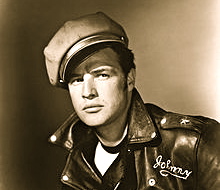
Marlon Brando Early Screen Test Rebel Without A Cause

Publicity photo for The Wild One (1953)
Marlon Brando, Jr. (April 3, 1924 – July 1, 2004) was an American screen and stage actor who was considered to be one of the most important actors in American cinema. Brando was one of only three professional actors, along with Charlie Chaplin and Marilyn Monroe, named by Time magazine as one of its 100 Persons of the Century in 1999.
Brando had a significant impact on film acting. While he became notorious for his “mumbling” diction and exuding a raw animal magnetism, his mercurial performances were nonetheless highly regarded, and he is widely considered as one of the greatest and most influential actors of the 20th century. Director Martin Scorsese said of him, “He is the marker. There’s ‘before Brando’ and ‘after Brando’.” Actor Jack Nicholson once said, “When Marlon dies, everybody moves up one.” Brando was ranked by the American Film Institute as the fourth greatest screen legend among male movie stars.
An enduring cultural icon, Brando became a box office star during the 1950s, during which time he racked up five Oscar nominations as Best Actor, along with three consecutive wins of the BAFTA Award for Best Actor in a Leading Role. He initially gained popularity for recreating the role as Stanley Kowalski in A Streetcar Named Desire (1951), a Tennessee Williams play that had established him as a Broadway star during its 1947-49 stage run; and for his Academy Award-winning performance as Terry Malloy in On the Waterfront (1954), as well as for his iconic portrayal of the rebel motorcycle gang leader Johnny Strabler in The Wild One (1953), which is considered to be one of the most famous images in pop culture. Brando was also nominated for the Oscar for playing Emiliano Zapata inViva Zapata! (1952); Mark Antony in Joseph L. Mankiewicz‘s 1953 film adaptation of Shakespeare‘s Julius Caesar; and as Air Force Major Lloyd Gruver in Sayonara (1957),Joshua Logan‘s adaption of James Michener‘s 1954 novel. Brando made the Top Ten Money Making Stars, as ranked by Quigley Publications’ annual survey of movie exhibitors, three times in the decade, coming in at number 10 in 1954, number 6 in 1955, and number 4 in 1958.
Brando directed and starred in the cult western film One-Eyed Jacks that was released in 1961, after which he delivered a series of box office failures beginning with the non-success of the 1962 film adaptation of Mutiny on the Bounty. The 1960s proved to be a fallow decade for Brando, and after 10 years in which he did not appear in a commercially successful movie, he won his second Academy Award for playing Vito Corleone in Francis Ford Coppola‘s The Godfather (1972), a role critics consider among his greatest. The movie, which became the most commercially successful film of all time when it was released — along with his Oscar-nominated performance as Paul in Last Tango in Paris (1972), another smash hit — revitalized Brando’s career and reestablished him in the ranks of top box office stars, placing him at number 6 and number 10 in Top 10 Money Making Stars poll in 1972 and 1973, respectively.
Brando failed to capitalize on the momentum of his revitalized career, taking a long hiatus before appearing in The Missouri Breaks (1976), a box office bomb. Afterward, he was content to be a highly paid character actor in parts that were glorified cameos in Superman (1978) and The Formula (1980) before taking a nine-year break from motion pictures. According to the Guinness Book of World Records, Brando was paid a record $3.7 million ($14,190,445 in today’s funds) plus 11.75% of the gross profits for 13 days work playing Jor-El in Superman, further adding to his mystique. He finished out the decade of the 1970s with his controversial performance as Colonel Walter Kurtz in another Coppola film, Apocalypse Now (1979), a box office hit for which he was highly paid and that helped finance his career layoff during the 1980s.
Brando was also an activist, supporting many issues, notably the African-American Civil Rights Movement and various American Indian Movements.
Early work
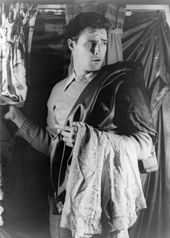 A 24-year-old Brando asStanley Kowalski on the set of the stage version of A Streetcar Named Desire, photographed by Carl Van Vechten in 1948
A 24-year-old Brando asStanley Kowalski on the set of the stage version of A Streetcar Named Desire, photographed by Carl Van Vechten in 1948
Brando used his Stanislavski System skills for his first summer-stock roles in Sayville, New York, on Long Island. His behavior got him kicked out of the cast of the New School’s production in Sayville, but he was discovered in a locally produced play there and then made it to Broadway in the bittersweet drama I Remember Mama in 1944. Critics voted him “Broadway’s Most Promising Actor” for his role as an anguished veteran in Truckline Café, although the play was a commercial failure. In 1946, he appeared on Broadway as the young hero in the political drama A Flag is Born, refusing to accept wages above the Actor’s Equity rate because of his commitment to the cause of Israeli independence. In that same year, Brando played the role of Marchbanks with Katharine Cornellin her production’s revival of Candida, one of her signature roles. Cornell also cast him as The Messenger in a her production of Jean Anouilh‘s Antigone that same year. Brando achieved stardom, however, as Stanley Kowalski in Tennessee Williams‘s 1947 play A Streetcar Named Desire, directed by Elia Kazan. Brando sought out that role, driving out to Provincetown, Massachusetts, where Williams was spending the summer, to audition for the part. Williams recalled that he opened the screen door and knew, instantly, that he had his Stanley Kowalski.
In 1947, Brando was asked to do a screen test for Warner Brothers. The screen test used an early script for Rebel Without A Cause that bears no relation to the film eventually produced in 1955. The screen test appears as an extra in the 2006 DVD release of A Streetcar Named Desire.
Brando’s first screen role was as the bitter paraplegic veteran in The Men in 1950. He spent a month in bed at the Birmingham Army Hospital in Van Nuys to prepare for the role. By Brando’s own account, it may have been because of this film that his draft status was changed from 4-F to 1-A. He had had an operation on the knee he had injured at Shattuck, and it was no longer physically debilitating enough to incur exclusion from the draft. When Brando reported to the induction center, he answered a questionnaire provided to him by saying his race was “human”, his color was “Seasonal-oyster white to beige”, and he told an Army doctor that he was psycho neurotic. When the draft board referred him to a psychiatrist, Brando explained how he had been expelled from military school and that he had severe problems with authority. Coincidentally, the psychiatrist knew a doctor friend of Brando, and Brando was able to avoid military service during the Korean War.
Rise to fame
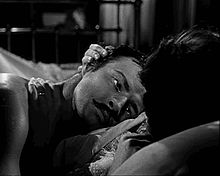 Brando as Emiliano Zapata in a trailer for the 1952 film Viva Zapata!
Brando as Emiliano Zapata in a trailer for the 1952 film Viva Zapata!
Brando brought his performance as Stanley Kowalski to the screen in Kazan’s adaptation of Tennessee Williams‘s A Streetcar Named Desire, and was nominated for an Academy Award for Best Actor for that role, and again in each of the next three years for his roles in Viva Zapata! in 1952, Julius Caesar in 1953 as Mark Antony, and On the Waterfront in 1954. These first five films of his career established him, as evidenced in his winning the BAFTA Award for Best Actor in a Leading Role in three consecutive years, 1951 to 1953.
In 1953, Brando also starred in The Wild One riding his own Triumph Thunderbird 6T motorcycle, which caused consternation to Triumph’s importers, as the subject matter was rowdy motorcycle gangs taking over a small town. But the images of Brando posing with his Triumph motorcycle became iconic, even forming the basis of his wax dummy at Madame Tussauds.
Later that same year, Brando starred in Lee Falk‘s production of George Bernard Shaw‘sArms and the Man in Boston. Falk was proud to tell people that Marlon Brando turned down an offer of $10,000 per week on Broadway, in favor of working on Falk’s play in Boston. His Boston contract was less than $500 per week. It was the last time he ever acted in a stage play.
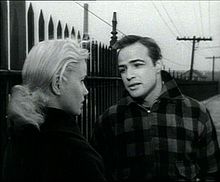 Marlon Brando with Eva Marie Saint in the trailer for On the Waterfront (1954)
Marlon Brando with Eva Marie Saint in the trailer for On the Waterfront (1954)
Brando won the Oscar for his role as Terry Malloy in On the Waterfront. For the famous I coulda’ been a contender scene, he convinced Kazan that the scripted scene was unrealistic, and, with Rod Steiger, improvised the final product.
Brando then took a variety of roles in the 1950s: portraying Napoleon in Désirée, Sky Masterson in the musical Guys and Dolls; Sakini, a Japanese interpreter for the U.S. Army in postwar Japan in The Teahouse of the August Moon; as a United States Air Force officer in Sayonara, and a German officer in The Young Lions.
In the 1960s, Brando starred in films such as One-Eyed Jacks (1961), a western that was the only film he ever directed; Mutiny on the Bounty (1962), The Chase (1966), and Reflections in a Golden Eye (1967), portraying a repressed gay army officer. It was the type of performance that later led critic Stanley Crouch to write, “Brando’s main achievement was to portray the taciturn but stoic gloom of those pulverized by circumstances.” He also played a guru in the sex farce Candy (1968). Burn! (1969), which Brando later claimed as his personal favorite, was a commercial failure. His career slowed down by the end of the decade as he gained a reputation for being difficult to work with.
The Godfather
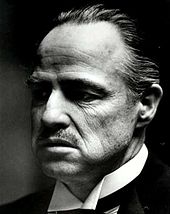 Brando as Don Vito Corleonein The Godfather (1972)
Brando as Don Vito Corleonein The Godfather (1972)
Brando’s performance as Vito Corleone or ‘the Don’ in 1972’s The Godfather was a mid-career turning point. Director Francis Ford Coppola convinced Brando to submit to a “make-up” test, in which Brando did his own makeup (he used cotton balls to simulate the puffed-cheek look). Coppola was electrified by his characterization as the head of a crime family, but he had to fight the studio in order to cast the temperamental actor. Mario Puzo always imagined Brando as Corleone. However, Paramount studio heads wanted to give the role to Danny Thomas in the hope that Thomas would have his own production company throw in its lot with Paramount. Thomas declined the role and urged the studio to cast Brando at the behest of Coppola and others who had witnessed the screen test.
Eventually, Charles Bluhdorn, the president of Paramount parent Gulf+Western, was won over to letting Brando have the role; when he saw the screen test, he asked in amazement, “What are we watching? Who is this old guinea?”
Brando won the Academy Award for Best Actor for his performance, but turned down the Oscar, becoming the second actor to refuse a Best Actor award (the first being George C. Scott for Patton). He boycotted the award ceremony, sending instead American Indian Rights activist Sacheen Littlefeather, who appeared in full Apache dress, to state Brando’s reasons, which were based on his objection to the depiction of American Indians by Hollywood and television.
The actor followed with Bernardo Bertolucci‘s 1973 film Last Tango in Paris, but the performance was overshadowed by an uproar over the erotic nature of the film. Despite the controversy which attended both the film and the man, the Academy once again nominated Brando for the Best Actor.
Brando, along with James Caan, was later scheduled in 1974 to appear in the final scene of The Godfather Part II. However, rewrites were made to the script when he refused to show up to the studio on the single day of shooting, due to disputes with the studio.


